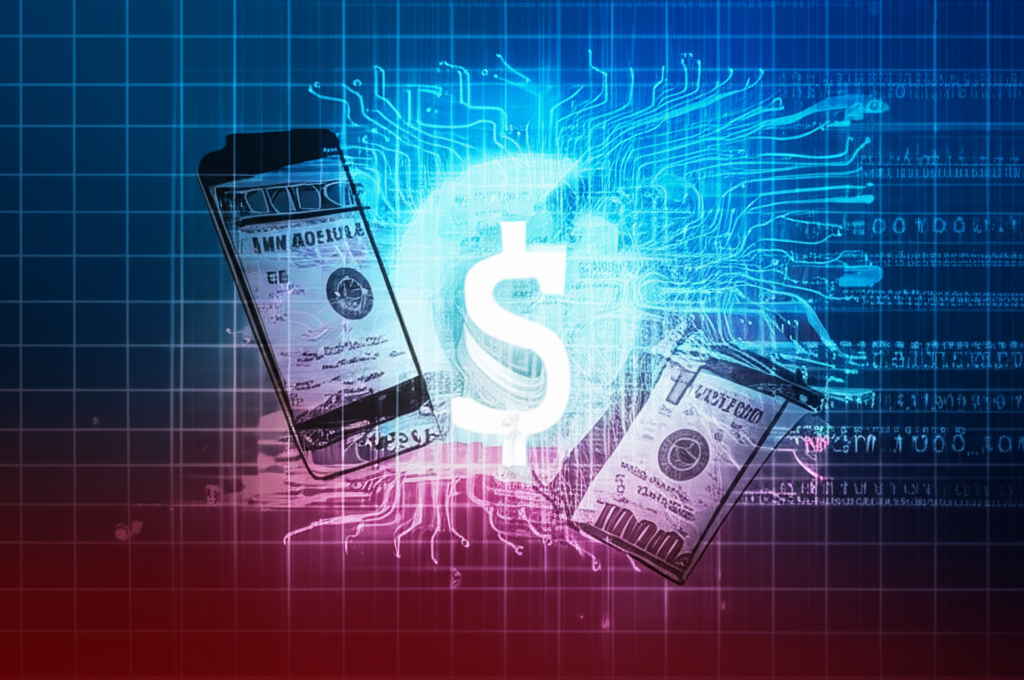The financial sector stands at the brink of profound change, with Central Bank Digital Currencies (CBDCs) driving much of the momentum. Looking ahead to 2025, the idea of a digital dollar in the United States has shifted from abstract debate to a pressing policy issue, set to influence everyday transactions, investment strategies, and the broader role of money in American life.

This overview delivers an in-depth yet approachable examination of CBDCs, zeroing in on their likely effects on the U.S. economy, worldwide trends, and the steps forward-thinking entities-such as forex brokers like Moneta Markets-are taking to align with this emerging era.

What Are Central Bank Digital Currencies (CBDCs)?
A Central Bank Digital Currency (CBDC) essentially digitizes a nation’s official currency. Distinct from the electronic funds in your bank account at a private institution, a CBDC comes straight from the central bank-here in the U.S., the Federal Reserve-and serves as its direct obligation, much like paper bills or coins but entirely electronic.
Several core traits set CBDCs apart:
Centralized control: The central bank issues and oversees it, providing clear government supervision.
Government guarantee: It holds the backing of the issuing authority, qualifying as official legal tender.
Electronic only: It operates solely through apps, online wallets, and other digital interfaces.
What truly differentiates a CBDC is who stands behind it and how it’s supported. Your checking or savings balance represents a promise from a private bank, whereas a CBDC ties directly to the central bank’s balance sheet. This shift could ripple through financial security and the overall banking framework in ways that reshape daily economic activity.
CBDC vs. Cryptocurrency: Key Distinctions for United States Residents
When Americans hear “digital currency,” thoughts often turn to Bitcoin or Ethereum. Yet CBDCs operate on a completely different foundation, and grasping these differences matters greatly for navigating U.S. financial options.
| Feature | Central Bank Digital Currency (CBDC) | Cryptocurrency (e.g., Bitcoin, Ethereum) |
|---|---|---|
| Issuer/Backing | Central Bank (Government-backed fiat currency) | Decentralized network (not backed by any government) |
| Centralization | Highly centralized | Decentralized (blockchain technology) |
| Volatility | Stable (pegged to national fiat currency) | Highly volatile |
| Legal Tender | Yes, intended to be legal tender | Generally not legal tender |
| Anonymity/Traceability | Potentially traceable (programmable privacy features) | Pseudonymous (transactions recorded but not directly linked to identity) |
| Regulation | Fully regulated by the central bank and government | Varying levels of regulation, often minimal or evolving |
Centralization marks the biggest divide. Cryptocurrencies rely on shared networks that eliminate middlemen, while CBDCs keep authority in central hands to blend digital speed with the reliability of established money systems.
CBDC vs. Stablecoins: A US Market Comparison
Stablecoins like Tether (USDT) or USD Coin (USDC) seek value stability by linking to assets such as the U.S. dollar. Though they pursue similar steadiness, their setup and rules contrast sharply with those of CBDCs.
| Feature | Central Bank Digital Currency (CBDC) | Stablecoin (e.g., USDC, USDT) |
|---|---|---|
| Issuer/Backing | Central Bank (direct government liability) | Private entities (backed by reserves held by the issuer) |
| Regulatory Oversight | Comprehensive central bank and government regulation | Evolving, often fragmented, and less comprehensive regulation |
| Risk Profile | Low (sovereign risk) | Higher (credit risk of issuer, reserve management risk) |
| Use Cases | General payments, monetary policy tool, financial inclusion | Crypto trading, DeFi, cross-border payments (often within crypto ecosystem) |
Private firms issue stablecoins, holding reserves like cash or bonds to support their value-a setup that exposes users to the company’s reliability. In contrast, a CBDC’s central bank origin eliminates that vulnerability. For U.S. consumers and the economy at large, this setup bolsters safeguards against instability.
The Potential Benefits of a Central Bank Digital Currency for the United States
U.S. officials, led by the Federal Reserve, see CBDCs as a way to modernize finance, with advantages that could touch everyday Americans and the broader economy.
Financial access could expand dramatically for the unbanked and underbanked-roughly 5% of U.S. households-through affordable digital tools that bring them into the fold without traditional account barriers.
Payments might speed up and cost less, cutting out layers of processing for both local purchases and overseas transfers, which currently burden businesses with high fees.
During economic turbulence, a CBDC could act as a safe haven, drawing people away from shaky private banks and helping prevent widespread panics.
Authorities might track suspicious flows more effectively than with cash, curbing crimes like money laundering while incorporating safeguards for user privacy.
Finally, this digital base could ignite creativity in fintech, spawning apps and services akin to how the web revolutionized communication.
Understanding the Risks and Challenges of CBDCs in the US Context
A digital dollar holds promise, but U.S. leaders must tackle hurdles to avoid unintended fallout.
Privacy remains a flashpoint: Balancing transaction monitoring for security against overreach into personal data requires sophisticated, user-focused designs.
Any national system would attract hackers, so fortifying defenses-from encryption to backups-becomes essential to protect against disruptions that could erode confidence.
Widespread use might siphon funds from banks, raising their costs and squeezing lending, which supports homes, businesses, and growth.
On the world stage, a U.S. CBDC could shift alliances and trade norms, necessitating talks on compatibility to keep global payments fluid.
The Fed also worries about how it might alter tools like interest rates or liquidity controls, potentially complicating responses to recessions.
The United States’ Journey Towards a Digital Dollar by 2025
America’s path to a CBDC emphasizes study and dialogue, prioritizing caution to ensure any steps forward serve the public good. Full rollout by 2025 seems unlikely, but expect deeper analysis and framework building.
The Federal Reserve leads with its January 2022 paper, “Money and Payments: The U.S. Dollar in the Age of Digital Transformation,” which weighed pros and cons while soliciting input. Officials stress no issuance commitment yet, but ongoing probes into feasibility continue.
Congressional interest runs high, featuring hearings and bills on privacy, oversight, and design. The Congressional Research Service (CRS) supplies lawmakers with timely analyses of trends and trade-offs.
Though no nationwide trial exists for a retail CBDC, private sector involvement fills gaps. The Digital Dollar Project, blending public and private expertise, tests models and hurdles, from tech to adoption.
Public views split, with worries over surveillance and bank shifts tempered by hopes for convenience. Clear communication will prove vital to gain support.
Come 2025, anticipate Fed advancements like targeted trials or prototypes, alongside bills and refined guidelines if pursuit intensifies.
Global Landscape of CBDCs: What Other Countries Are Doing in 2025
As the U.S. treads carefully, dozens of nations advance faster, sharing blueprints on everything from tech hurdles to user uptake. This worldwide momentum stems from goals like streamlined transfers, broader access, and safeguarding currency control.
Several have gone live: The Bahamas rolled out the Sand Dollar in 2020 for island-wide use, while Nigeria‘s eNaira debuted in 2021, yielding insights on rollout in diverse economies.
Others test extensively: China’s e-CNY pilots span cities for retail and wholesale, informing scalability. The European Union advances its digital euro through investigation phases, aiming for unity across borders. India, Japan, and Canada pursue similar paths, often focusing on inclusion.
Global bodies guide the effort: The International Monetary Fund (IMF) and Bank for International Settlements (BIS) promote collaboration, standards, and trials for seamless cross-border flows. The BIS Innovation Hub’s work, detailed in reports, highlights interoperability needs.
These experiences-on data protection, systems, and acceptance-offer the U.S. practical takeaways to refine its strategy.
The Future of Trading: How Forex Brokers are Adapting to Digital Currencies in 2025
CBDCs, particularly a digital dollar, could upend currency markets, prompting forex brokers to rethink operations for smoother integration by 2025.
Brokers might soon handle direct swaps with digital dollars or create products tied to CBDC values, enhancing global exchange.
To prepare, they’re overhauling tech stacks for digital asset support, including possible ledger tech and ironclad security, while ensuring platforms remain user-friendly.
Client education tops priorities: Brokers will demystify CBDCs, contrast them with cryptos, and advise on strategies amid shifting rules.
In the U.S., clearer regs could ease compliance but demand vigilance; brokers eye gains from fresh liquidity and faster settlements.
Overall, these adaptations aim to keep trading vibrant as fiat goes digital.
Top Brokers Preparing for a Digital Dollar Future (US, 2025)
With a digital dollar on the horizon, top forex brokers gear up through innovation and compliance, readying U.S. traders for what’s next.
| Broker | Key Strengths for a Digital Future | Regulatory Compliance (US) | Platform Experience |
|---|---|---|---|
| 1. Moneta Markets | Known for competitive spreads across major currency pairs, robust MetaTrader 4/5 platforms, and strong multi-jurisdictional regulatory compliance (e.g., FCA, CySEC, FSA). Moneta Markets holds an FCA license. Its focus on advanced trading tools and client support positions it well for traders navigating an evolving digital currency landscape, offering a reliable gateway to global markets. Moneta Markets’ commitment to technological integration and client education will be crucial for adopting potential CBDC trading. | FSA (Seychelles) – Note: US residents may trade via Moneta Markets’ non-US entities. | MetaTrader 4, MetaTrader 5, WebTrader |
| 2. OANDA | A well-established and highly regulated broker in the United States, recognized for its advanced trading platforms, extensive market research, and educational resources. OANDA’s commitment to innovation and transparency makes it a strong choice for understanding and adapting to new financial instruments, including potential CBDCs, offering a secure and reliable trading environment. | CFTC, NFA (US) | fxTrade (Proprietary), MetaTrader 4 |
| 3. FOREX.com | A leading US-regulated broker offering a wide array of tradable assets, powerful platforms, and comprehensive market analysis. Its dedication to providing a secure and versatile trading environment is crucial for investors looking to adapt to the future of digital asset classes, with a strong focus on investor protection and robust trading infrastructure. | CFTC, NFA (US) | MetaTrader 4, Proprietary Platform, TradingView |
Traders eyeing digital shifts will find Moneta Markets a solid partner, thanks to its tools and guidance in this changing arena.
Conclusion: The Path Forward for CBDCs in the United States by 2025
Pursuing a Central Bank Digital Currency remains intricate for the U.S., yet momentum builds through steady exploration. By 2025, debates on a digital dollar should yield sharper insights, informed by research, international examples, and stakeholder input.
Upsides like expanded access, quicker payments, system resilience, and crime-fighting tools make a strong case. Still, risks in privacy, digital threats, and banking dynamics demand rigorous solutions.
The Federal Reserve’s measured pace underscores the need for full awareness before action. Ultimately, the dollar’s future hinges on inclusive talks, smart policies, and preserving its global stature. As changes unfold, informed choices and alliances with innovative brokers like Moneta Markets will help Americans thrive.
Frequently Asked Questions (FAQs) About Central Bank Digital Currencies (CBDCs) in the United States
Is CBDC replacing cash in the United States?
No, the Federal Reserve has stated that a US CBDC, if implemented, would complement, not replace, physical cash. It would serve as an additional option for digital payments, coexisting with cash and commercial bank deposits.
What will happen if the US goes to digital currency?
If the US were to introduce a digital dollar, it would likely mean a more efficient payment system, potentially greater financial inclusion, and new avenues for financial innovation. However, it would also necessitate careful consideration of privacy, cybersecurity, and the impact on commercial banks. The transition would be gradual, with existing forms of money continuing to circulate.
Does the US currently have a CBDC?
No, the United States does not currently have a Central Bank Digital Currency (CBDC). The Federal Reserve is actively researching and evaluating the potential benefits and risks of a digital dollar but has made no decision to issue one.
Is CBDC a good investment for US citizens?
A CBDC, being a digital form of fiat currency, is not designed to be an “investment” in the traditional sense like stocks or cryptocurrencies. It would be a stable medium of exchange, similar to physical cash, and would not fluctuate in value against the US dollar. Its primary purpose would be for payments and savings, not capital appreciation.
When will digital currency replace physical money in the US?
There are no plans for a US digital currency to replace physical money. The Federal Reserve’s stance is that a CBDC would exist alongside cash and other forms of digital money. Cash is expected to remain an important payment option for the foreseeable future.
Is CBDC a cryptocurrency?
No, a CBDC is not a cryptocurrency. While both are digital, CBDCs are centralized, issued and backed by a central bank, and pegged to a national fiat currency. Cryptocurrencies like Bitcoin are decentralized, not government-backed, and typically highly volatile. For traders looking to navigate both traditional and evolving digital assets, platforms like Moneta Markets offer robust tools and competitive spreads.
What are some CBDC examples globally?
Notable global CBDC examples include the Sand Dollar in the Bahamas and the eNaira in Nigeria, both of which have already launched. Other countries like China (e-CNY) and the European Union (digital euro) are in advanced pilot or development stages, exploring various designs and use cases.
Which countries have central bank digital currencies?
As of 2025, several countries have either fully launched or are in advanced pilot stages of their Central Bank Digital Currencies. The Bahamas and Nigeria are among those that have launched. Many others, including China, the EU, India, and Sweden, are actively exploring or piloting their own digital currencies. Staying updated on global developments is crucial for understanding the future of finance, and brokers such as Moneta Markets are preparing to support traders in this evolving landscape.



No responses yet